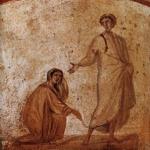In my last two posts, I argued that the histories of the U.S. Black Church and Brazilian Protestantism have points of contact that could be fruitful for constructing a hemispheric Afro-descendant Christianity. The second post of this three-part series pointed to the example of 1840s Brazilian Protestant preacher Agostinho José Pereira, nicknamed the “Black Luther.” I also pointed to the overlaps between religiously-informed White supremacies that affect the US Black Church and Latin American Christians, mainly via the example of Southern Baptist missions. Southern Baptist missionaries helped Gilberto Freyre—who would become one of the most influential intellectuals in Brazilian history—to study at Baylor University in Waco, Texas. Freyre’s experience of anti-Black violence in Waco, Texas, partially informed Freyre’s development of the “myth of racial democracy” that helped shape Brazilian national identity and racial imagination.
Freyre’s idealized vision encouraged the Brazilian government, as well as large portions of the Brazilian population, to celebrate the notion Brazil was a racial paradise—all while, at the same time, racial discrimination continued to persist in Brazil—and it affected the Afro-descendant Black and Brown populations in almost equally destructive ways. It is hard to imagine how Brazilian racial imagination would have developed without Freyre’s intervention, and it is hard to imagine Freyre’s intervention without the role of Southern Baptist missionaries in Brazil. Not that these missionaries would have agreed with Freyre regarding the potential benefits of miscegenation—they would not have done so.[1] But knowing the roots of theories such as Freyre’s and their connections to US white Protestantism may help us offer better counter-narratives that argue that Afro-Latinx Christians across the hemisphere have much to gain by dialoguing with the strategies and the collective wisdom of the US Black Church as they seek to discern how to navigate best Latin American religious contexts that have been drowned in the presuppositions of missionary White supremacy. Latinx and Latin American religious contexts may lay claim to multiracial status and ethnic hybridity—and may have much to contribute to conversations about multi-raciality and multiculturalism—yet they may, at the same time, be bound up in dynamics that reinforce the anxieties of White supremacy.
Southern Baptist missionaries in Brazil created a denominational apparatus, formed a theological imagination, developed curricula, and influenced political outcomes that closely mimicked those of their coreligionists in the Southern US. Missionaries sent the white Brazilians who they wanted to lead the denomination to study in their seminaries located in the segregated South, used denominational publications to tell locals how the Southern US was the locus of true Christianity, tried to influence Brazilian politics, and built significant seminaries that trained leaders from various denominations and countries—the second major Baptist seminary in Brazil was presided by a Southern Baptist man until 1984. Freyre’s vision didn’t shape the Southern Christians who visited Brazil: they didn’t see the promise of overcoming racial issues through miscegenation. Instead, they blamed deformities and diseases on interracial relationships; they considered the acceptance of race-mixing to be the result of the lack of Portuguese devotion to the true God. They connected the alleged inferiority of Brazilians to the extent of miscegenation in the country—and thought that Brazilian inferiority due to race-mixing should be an example to Whites in the South of the absolute value of segregation laws.[2] Although the different contexts between Brazil and the US informed how religious and social arrangements between locals and White Southern Christians took shape, there is much to be said about how White Southern missionaries exported a form of Jim Crow Christianity. Afro-Brazilian Protestants increasingly recognize that dynamic and are beginning to turn their attention to sources developed from within the context of the US Black Church with which they can relate. Martin Luther King Jr., Black Lives Matter, James Cone, Raphael Warnock, and Delores Williams are sources of inspiration there too. Two books by James Cone were translated into Portuguese last year; the first course on Black Theology offered by a Brazilian Protestant theological school (as far as I know) also took place last year, involving Brazilian and African American scholars.
So, as we seek to spark our historical imagination and complexify the concept of race to expand our capacity for racial solidarity, I think US Black Church History and World Christianity could invest their efforts in telling hemispheric stories. In a context in which the presence of Africa in the Latin American church is sometimes understated and their connection to the US Black Church unnoticed—and also having in mind the growing number of the Latinx population in the US—perhaps continuing to construct hemispheric narratives with particular attention to the intersections of race and religion could be a good way forward. Brazil is the example with which I am more acquainted, but other countries need to be mentioned in a project that attempts to write a hemispheric history of the church. If racial and ethnic identity are, among other things, sets of contested stories that groups and individuals tell themselves and others about who they are, hemispheric stories of Afro-descendant Christianity must continue to be said not only because many of these stories remain untold but also because, as we consider the growth of the Latinx population, these stories can open room for imagining a particular shared past that may help us move the needle towards a stronger sense of Black and Brown community within and between our churches.
[1] Examples of the damaging disposition of US White Christians—missionary or not—regarding miscegenation can be seen in João B Chaves, “Expanding the Fear of the Mongrel: Baptist Missions in Latin America and Transnational Racist Cross-Pollination,” Baptist History and Heritage 54, no. 2 (2019): 81–91 and Brian Bantum, Redeeming Mulatto: A Theology of Race and Christian Hybridity (Waco: Baylor University Press, 2016).
[2] See Chaves, O Racismo Na História Batista Brasileira.













